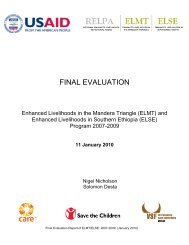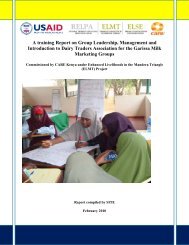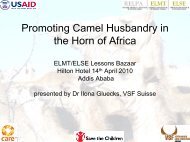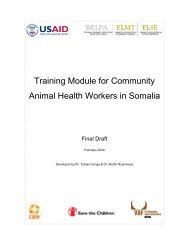Impact Assessment of the Community Animal Health System in ...
Impact Assessment of the Community Animal Health System in ...
Impact Assessment of the Community Animal Health System in ...
You also want an ePaper? Increase the reach of your titles
YUMPU automatically turns print PDFs into web optimized ePapers that Google loves.
and studies <strong>in</strong> Kenya which exam<strong>in</strong>e <strong>the</strong> f<strong>in</strong>ancial susta<strong>in</strong>ability <strong>of</strong> CAH systems <strong>in</strong>volv<strong>in</strong>g private<br />
pharmacies as <strong>the</strong> ma<strong>in</strong> local source <strong>of</strong> veter<strong>in</strong>ary drugs 14 .<br />
In Kenya, cl<strong>in</strong>ical animal health service delivery requires veter<strong>in</strong>ary workers to sources <strong>in</strong>puts from<br />
private suppliers. However, <strong>the</strong> more reputable suppliers are located <strong>in</strong> <strong>the</strong> ma<strong>in</strong> urban centers and <strong>in</strong><br />
pastoralist areas a highly unethical trade <strong>in</strong> veter<strong>in</strong>ary drug supply has evolved, with consequent<br />
risks <strong>of</strong> drug misuse. Due to <strong>the</strong> absence <strong>of</strong> properly regulated and licensed sources <strong>of</strong> veter<strong>in</strong>ary<br />
drugs, various petty traders and untra<strong>in</strong>ed practitioners have stepped <strong>in</strong> to fill <strong>the</strong> gap. This is<br />
unacceptable from a legal and ethical perspective, yet it is clearly <strong>the</strong> role <strong>of</strong> government veter<strong>in</strong>arians<br />
and related agencies to ensure quality control <strong>of</strong> veter<strong>in</strong>ary drugs <strong>in</strong> <strong>the</strong> country.<br />
In <strong>the</strong> CAH system covered <strong>in</strong> this assessment, <strong>the</strong> private veter<strong>in</strong>ary practitioners and <strong>the</strong> CAHWs<br />
<strong>in</strong>vested <strong>the</strong>ir own capital to establish or revitalize pharmacies and acquire stocks <strong>of</strong> drugs. This<br />
<strong>in</strong>dicates a strong personal commitment to <strong>the</strong>se bus<strong>in</strong>esses. However, <strong>the</strong> private practitioners and<br />
CAHWs were concerned that it may be difficult for <strong>the</strong>m to compete with o<strong>the</strong>r private practitioners<br />
(<strong>in</strong>clud<strong>in</strong>g o<strong>the</strong>r CAHWs) who receive material and f<strong>in</strong>ancial supports from NGOs operat<strong>in</strong>g <strong>in</strong> <strong>the</strong><br />
adjacent areas. In addition, dur<strong>in</strong>g drought <strong>the</strong>ir stocks <strong>of</strong> veter<strong>in</strong>ary drugs can expiry as livestock<br />
move to neighbor<strong>in</strong>g countries, and free drugs that may be delivered <strong>in</strong> response to drought by<br />
NGOs, UN agencies or <strong>the</strong> Government <strong>of</strong> Kenya. These f<strong>in</strong>d<strong>in</strong>gs po<strong>in</strong>t to a need to support <strong>the</strong> CAH<br />
and private pharmacy system <strong>in</strong> times <strong>of</strong> drought with veter<strong>in</strong>ary voucher schemes, which have<br />
already been piloted <strong>in</strong> pastoral areas <strong>of</strong> Kenya and are a better alternative to free drug distribution 15 .<br />
Similarly, some pastoralists stated that CAHWs were not always available where needed most,<br />
especially at times <strong>of</strong> drought when herds migrate to Ethiopia and Somalia. The CAHWs <strong>in</strong>dicated<br />
<strong>the</strong>y follow herds to Ethiopia dur<strong>in</strong>g normal years. With<strong>in</strong> Ethiopia <strong>the</strong>re is a promis<strong>in</strong>g trend<br />
towards more use <strong>of</strong> local, private sector workers to implement emergency veter<strong>in</strong>ary <strong>in</strong>terventions <strong>in</strong><br />
pastoral areas. This <strong>in</strong>dicates a need for cross‐border harmonization <strong>of</strong> CAH systems <strong>in</strong> normal<br />
periods, plus harmonization <strong>of</strong> veter<strong>in</strong>ary voucher schemes or similar approaches dur<strong>in</strong>g drought.<br />
Quality <strong>of</strong> CAHW treatments<br />
Dur<strong>in</strong>g <strong>the</strong> last two decades <strong>the</strong>re has been considerable debate <strong>in</strong> <strong>the</strong> veter<strong>in</strong>ary establishment <strong>in</strong><br />
Kenya over <strong>the</strong> use <strong>of</strong> CAHWs. One aspect <strong>of</strong> <strong>the</strong> debate has focused on <strong>the</strong> ability <strong>of</strong> CAHWs to<br />
diagnose diseases and use veter<strong>in</strong>ary medic<strong>in</strong>es correctly. Although <strong>the</strong>re is no standard method <strong>of</strong><br />
measur<strong>in</strong>g CAHW cl<strong>in</strong>ical competence, various studies <strong>in</strong> Kenya have shown that when well‐tra<strong>in</strong>ed<br />
and supervised, CAHWs can provide a sufficient level <strong>of</strong> cl<strong>in</strong>ical competence and have positive<br />
impact on livelihoods 16 . In contrast, <strong>the</strong>re seem to be no studies available which reach an opposite<br />
conclusion.<br />
This assessment exam<strong>in</strong>ed <strong>the</strong> impact <strong>of</strong> CAHW treatments on livestock fatality and did not measure<br />
production‐related losses or impacts. The post‐treatment fatality rates <strong>in</strong> CAHW‐treated herds <strong>in</strong> this<br />
14 Some key references are:<br />
Kaberia, B.K. (2002). ibid.<br />
Ririmpoi, B. (2002). ibid.<br />
Leonard D.K. (1987). The supply <strong>of</strong> veter<strong>in</strong>ary services: Kenyan lessons. Agric. Adm<strong>in</strong>. Extens. 26 (4), 219‐236.<br />
Okwiri F.O., Kajume J.K. and Odondi R.K. (2001). An assessment <strong>of</strong> <strong>the</strong> economic viability <strong>of</strong> private animal health service<br />
delivery <strong>in</strong> pastoral areas <strong>in</strong> Kenya. African Union/Interafrican Bureau for <strong>Animal</strong> Resources, Nairobi, 80 pp.<br />
15 Livestock Emergency Guidel<strong>in</strong>es and Standards (2009). http://www.livestock‐emergency.net<br />
16 Key references <strong>in</strong>clude:<br />
Odhiambo O., Holden S. and Ackello‐Ogutu C. (1998). Oxfam Wajir pastoral development project: an economic impact<br />
assessment. Oxfam UK/Ireland, Nairobi, 23 pp.<br />
Rubyogo, J.C., Murithii, P.M., Agumbah, G.J.O and Obhai, G. (2005). <strong>Assessment</strong> <strong>of</strong> <strong>the</strong> Technical Competence and Ethical<br />
Behaviour <strong>of</strong> <strong>Community</strong>‐based <strong>Animal</strong> <strong>Health</strong> Workers <strong>in</strong> Mw<strong>in</strong>gi District, Kenya,. Tropical <strong>Animal</strong> <strong>Health</strong> and Production 37(4),<br />
267‐276.<br />
14












